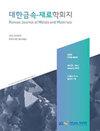Optimization of Sintering Temperature for the Synthesis of n-type Mg<sub>3</sub>SbBi<sub>0.99</sub>Te<sub>0.01</sub> Thermoelectric Materials
IF 1.1
4区 材料科学
Q4 MATERIALS SCIENCE, MULTIDISCIPLINARY
引用次数: 0
Abstract
Mg3Sb2-based materials are promising candidates to replace n-type Bi2Te3 for cooling and power generation at low temperatures. Generally, the thermoelectric performance of a material is sensitively affected by synthesis process parameters, and among them, sintering temperature (Ts) is a critical one. In this study, n-type Mg3SbBi0.99Te0.01 polycrystalline samples were fabricated by mechanical alloying and spark plasma sintering (SPS), and the effects of varying Ts (923 – 1073 K) on the thermoelectric properties were investigated. Sintering Mg3SbBi0.99Te0.01 at an elevated temperature of 1073 K resulted in a notable increase in electrical conductivity at low temperatures below about 423 K. This is ascribed to a sharp reduction in carrier scattering by ionized impurities. For the same reason, the carrier mobility increased sharply at a Ts of 1073 K, which is a critical temperature for sintering in this study. Moreover, the Seebeck coefficient increased and thermal conductivity decreased simultaneously by raising Ts, resulting in the maximum power factor (PFmax) of 2.2 × 10-3 W m-1K-2 and the maximum dimensionless figure of merit (zTmax) of 1.20 in the sample sintered at 1073 K. Therefore, when Ts was raised from 923 K to 1073 K, the PFmax and zTmax increased by 29 % and 64 %, respectively. This improvement in performance is attributed to the annihilation of defects generated during the mechanical alloying process, which was confirmed by microstructure analysis by transmission electron microscopy (TEM).n型Mg<sub>3</sub>SbBi<sub>0.99</sub>Te<sub>0.01</sub>热电材料
mg3sb2基材料有望取代n型Bi2Te3用于低温冷却和发电。一般来说,材料的热电性能受合成工艺参数的影响比较敏感,其中烧结温度(<i>Ts</i>)是一个关键温度。本研究采用机械合金化和放电等离子烧结(SPS)法制备了n型Mg3SbBi0.99Te0.01多晶样品,研究了不同的<i>Ts</i>研究了923 ~ 1073 K温度对热电性能的影响。在1073 K的高温下烧结Mg3SbBi0.99Te0.01,在423 K以下的低温下电导率显著提高。这归因于离子化杂质对载流子散射的急剧减少。由于同样的原因,载流子迁移率在a <i>Ts</i>1073 K,这是本研究烧结的临界温度。通过提高<i>Ts</i>, Seebeck系数增大,导热系数降低,导致1073 K烧结试样的最大功率因数(<i>PFmax</i>)为2.2 × 10-3 W m-1K-2,最大无因次优值(<i>zTmax</i>)为1.20。因此,当<i>Ts</i>从923 K提高到1073 K, PFmax</i>和& lt; i> zTmax< / i>分别增长29%和64%。这种性能的提高是由于消除了机械合金化过程中产生的缺陷,透射电子显微镜(TEM)的微观结构分析证实了这一点。
本文章由计算机程序翻译,如有差异,请以英文原文为准。
求助全文
约1分钟内获得全文
求助全文
来源期刊

Korean Journal of Metals and Materials
MATERIALS SCIENCE, MULTIDISCIPLINARY-METALLURGY & METALLURGICAL ENGINEERING
CiteScore
1.80
自引率
58.30%
发文量
100
审稿时长
4-8 weeks
期刊介绍:
The Korean Journal of Metals and Materials is a representative Korean-language journal of the Korean Institute of Metals and Materials (KIM); it publishes domestic and foreign academic papers related to metals and materials, in abroad range of fields from metals and materials to nano-materials, biomaterials, functional materials, energy materials, and new materials, and its official ISO designation is Korean J. Met. Mater.
 求助内容:
求助内容: 应助结果提醒方式:
应助结果提醒方式:


